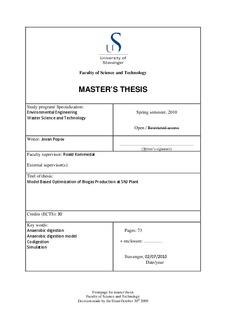| dc.contributor.author | Popov, Jovan | |
| dc.date.accessioned | 2010-11-05T09:57:53Z | |
| dc.date.available | 2010-11-05T09:57:53Z | |
| dc.date.issued | 2010 | |
| dc.identifier.uri | http://hdl.handle.net/11250/182428 | |
| dc.description | Master's thesis in Environmental technology : water science | en_US |
| dc.description.abstract | The main purpose of this thesis is the acquisition of knowledge and familiarization with the
SNJ biogas plant and effects of codigestion. Plant operation and performance was
monitored in order to understand and evaluate the factors affecting the efficiency of the
sludge treatment process. The thesis also presents an overview of anaerobic digestion
process, modelling of anaerobic codigestion process, and a general presentation of the
Regional Wastewater Treatment Plant of Nord‐Jæren (SNJ). More precisely, the study
provides experimental data of several parameters at SNJ plant. Methane production and
Chemical Oxygen Demand (COD) removals were quantified under steady state conditions
for a wide range of operating parameters. Mathematical model (ADM1) was successfully
adapted to reactor system. Non‐steady state analysis was performed to assess the effect of
food waste loading on biogas production by codigestion.
Calculations reveal that 0.6142 m3 of methane is produced per kg COD removal, based on
theoretically estimated biogas production by using the measured data. There is big
discrepancy of 29.7% in comparison between the theoretical estimated methane production
and the actual methane production measured at SNJ plant. The Volatile Suspended Solids
(VSS) reduction during the digestion of raw sludge along with septic sludge and food waste
was 58.69%. Likewise, Total Suspended Solids (TSS) reduction was calculated as 47.57%.
Results gained by simulation showed differences between the steady state and measured
data. The simulated biogas production showed lower values then the measured at SNJ.
The result of non‐steady state analysis shows that the biogas production had increased by
62 % in reactor 1 in comparison with reactor 2. The biogas production obtained here, by the
addition of food waste, could be attributed to the higher biodegradability of food waste. On
the other hand, the high contents of polysaccharides and assembly the carbohydrates in the
food waste have been recognized as a main reason for the increased biogas production.
Therefore, food waste codigestion with raw sludge is a sustainable and environmentally
attractive method to treat and simultaneously convert such a waste mixture to a useful
energy source. | en_US |
| dc.language.iso | eng | en_US |
| dc.publisher | University of Stavanger, Norway | en_US |
| dc.relation.ispartofseries | Masteroppgave/UIS-TN-IMN/2010; | |
| dc.subject | teknisk miljøvern | en_US |
| dc.subject | vann | en_US |
| dc.subject | anaerobic digestion | en_US |
| dc.subject | anaerobic digestion model | en_US |
| dc.subject | codigestion | en_US |
| dc.subject | simulation | en_US |
| dc.title | Model based optimization of biogas production at SNJ plant | en_US |
| dc.type | Master thesis | en_US |
| dc.subject.nsi | VDP::Technology: 500::Environmental engineering: 610 | en_US |
| dc.source.pagenumber | 85 p. | en_US |
